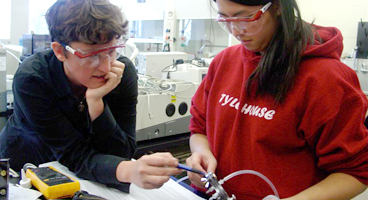Chemical Evolution of Volatile Organic Compounds in the Outflow of the Mexico City Metropolitan Area
Document Type
Article
Publication Date
1-1-2010
Publication Title
Atmospheric Chemistry and Physics
Abstract
The volatile organic compound (VOC) distribution in the Mexico City Metropolitan Area (MCMA) and its evolution as it is uplifted and transported out of the MCMA basin was studied during the 2006 MILAGRO/MIRAGE-Mex field campaign. The results show that in the morning hours in the city center, the VOC distribution is dominated by non-methane hydrocarbons (NMHCs) but with a substantial contribution from oxygenated volatile organic compounds (OVOCs), predominantly from primary emissions. Alkanes account for a large part of the NMHC distribution in terms of mixing ratios. In terms of reactivity, NMHCs also dominate overall, especially in the morning hours. However, in the afternoon, as the boundary layer lifts and air is mixed and aged within the basin, the distribution changes as secondary products are formed. The WRF-Chem (Weather Research and Forecasting with Chemistry) model and MOZART (Model for Ozone and Related chemical Tracers) were able to approximate the observed MCMA daytime patterns and absolute values of the VOC OH reactivity. The MOZART model is also in agreement with observations showing that NMHCs dominate the reactivity distribution except in the afternoon hours. The WRF-Chem and MOZART models showed higher reactivity than the experimental data during the nighttime cycle, perhaps indicating problems with the modeled nighttime boundary layer height.
A northeast transport event was studied in which air originating in the MCMA was intercepted aloft with the Department of Energy (DOE) G1 on 18 March and downwind with the National Center for Atmospheric Research (NCAR) C130 one day later on 19 March. A number of identical species measured aboard each aircraft gave insight into the chemical evolution of the plume as it aged and was transported as far as 1000 km downwind; ozone was shown to be photochemically produced in the plume. The WRF-Chem and MOZART models were used to examine the spatial extent and temporal evolution of the plume and to help interpret the observed OH reactivity. The model results generally showed good agreement with experimental results for the total VOC OH reactivity downwind and gave insight into the distributions of VOC chemical classes. A box model with detailed gas phase chemistry (NCAR Master Mechanism), initialized with concentrations observed at one of the ground sites in the MCMA, was used to examine the expected evolution of specific VOCs over a 1ĝ€"2 day period. The models clearly supported the experimental evidence for NMHC oxidation leading to the formation of OVOCs downwind, which then become the primary fuel for ozone production far away from the MCMA.
Volume
10
Issue
5
First Page
2353
Last Page
2376
DOI
10.5194/acp-10-2353-2010
ISSN
16807316
Creative Commons License

This work is licensed under a Creative Commons Attribution 3.0 License.
Rights
© Author(s) 2010
Recommended Citation
Apel, E. C.; Emmons, L. K.; Karl, T.; Flocke, F.; Hills, A. J.; Madronich, S.; Lee-Taylor, J.; Fried, A.; Weibring, P.; Walega, J.; Richter, D.; Tie, X.; Mauldin, L.; Campos, T.; Weinheimer, A.; Knapp, D.; Sive, B.; Kleinman, L.; Springston, S.; Zaveri, R.; Ortega, J.; Voss, Paul; Blake, D.; Baker, A.; Warneke, C.; Welsh-Bon, D.; De Gouw, J.; Zheng, J.; Zhang, R.; Rudolph, J.; Junkermann, W.; and Riemer, D. D., "Chemical Evolution of Volatile Organic Compounds in the Outflow of the Mexico City Metropolitan Area" (2010). Engineering: Faculty Publications, Smith College, Northampton, MA.
https://scholarworks.smith.edu/egr_facpubs/64


Comments
Archived as published. Open access article.